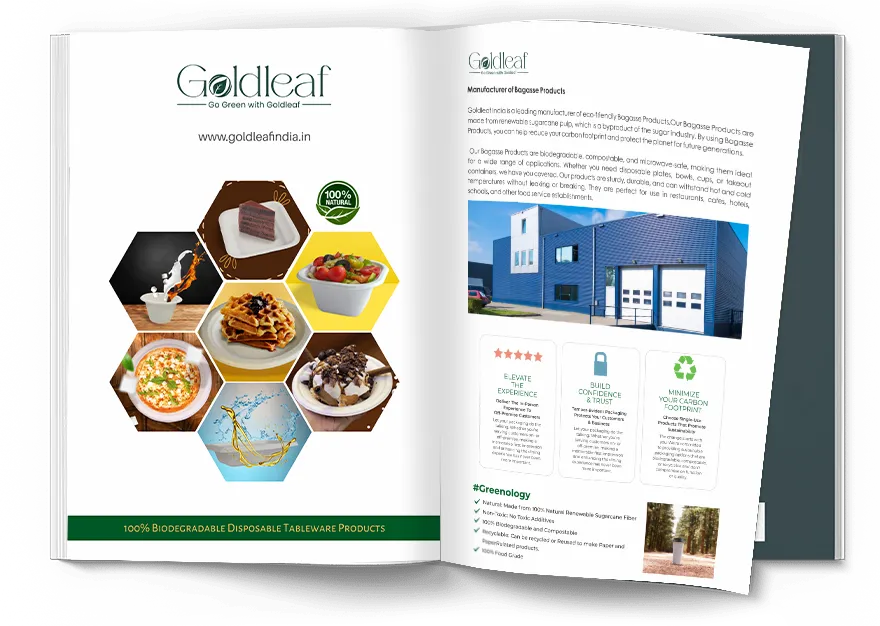تواصل مع فريقنا
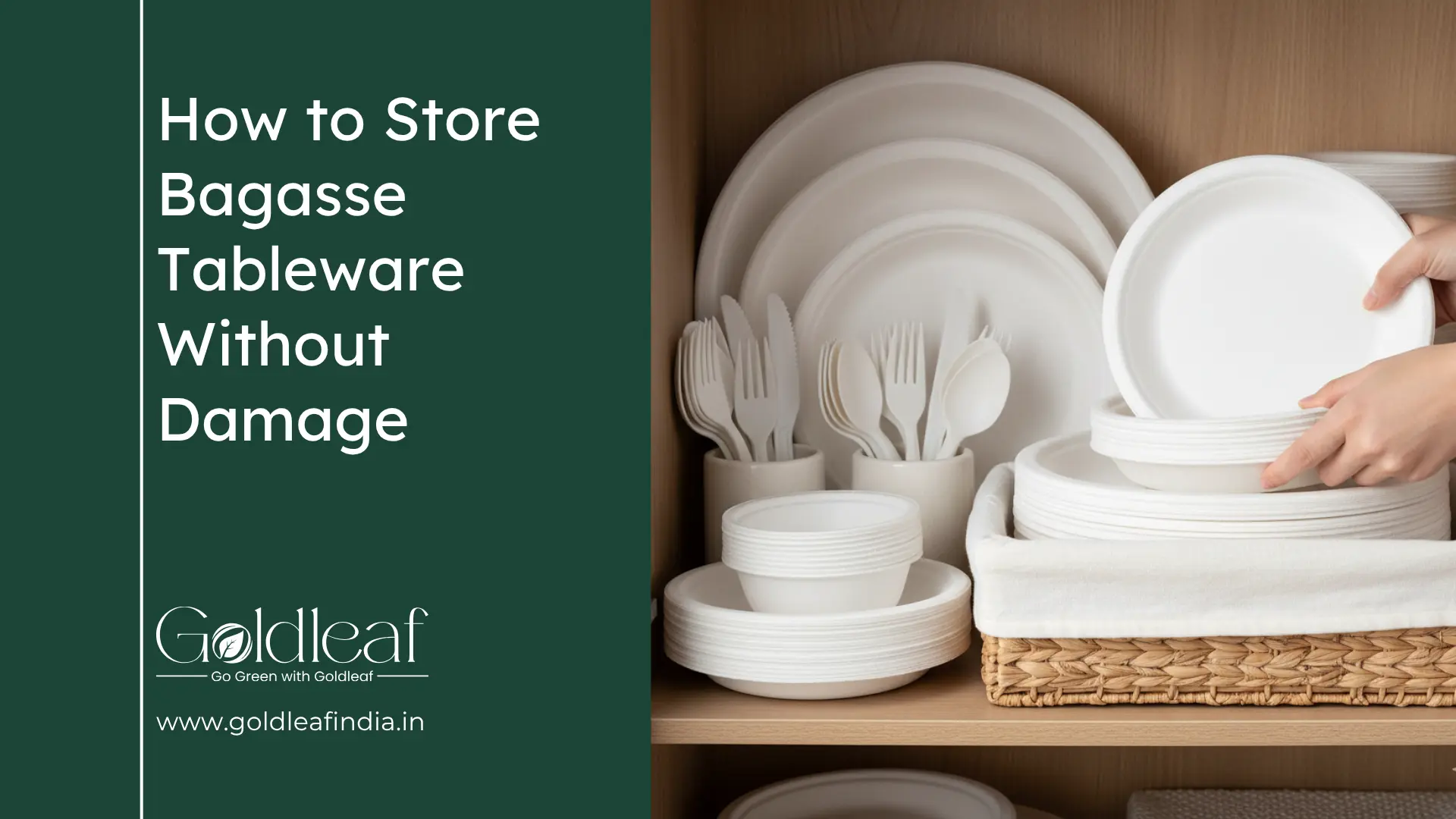
- 706
So, you've got some bagasse tableware and want to keep it in good shape? It's a great eco-friendly choice, but like anything, it needs a little care to last. Whether you're storing it for a bit before use or after washing, knowing the best way to handle it makes a difference. Let's talk about how to keep your bagasse tableware from getting damaged, so you can keep using it without worry.
Key Takeaways
• Bagasse tableware, made from sugarcane byproducts, is a good eco-friendly option. It's important to check its material consistency, strength, and how well it holds up to heat and liquids.
• Keep your bagasse tableware dry and ventilated during storage. Avoid stacking too many pieces tightly, and store them in a stable place away from extreme conditions.
• To prevent damage, handle bagasse tableware gently to avoid cracking. Don't expose it to excessive heat or prolonged contact with very oily foods, as this can affect its integrity.
• When storing bagasse tableware, make sure it's clean and completely dry first. This helps prevent mold or degradation before you use it again.
• Understanding the limits of bagasse tableware, like its response to prolonged moisture or high heat, helps you use and store it correctly, making it last longer.
Optimal Storage Conditions For Bagasse Tableware
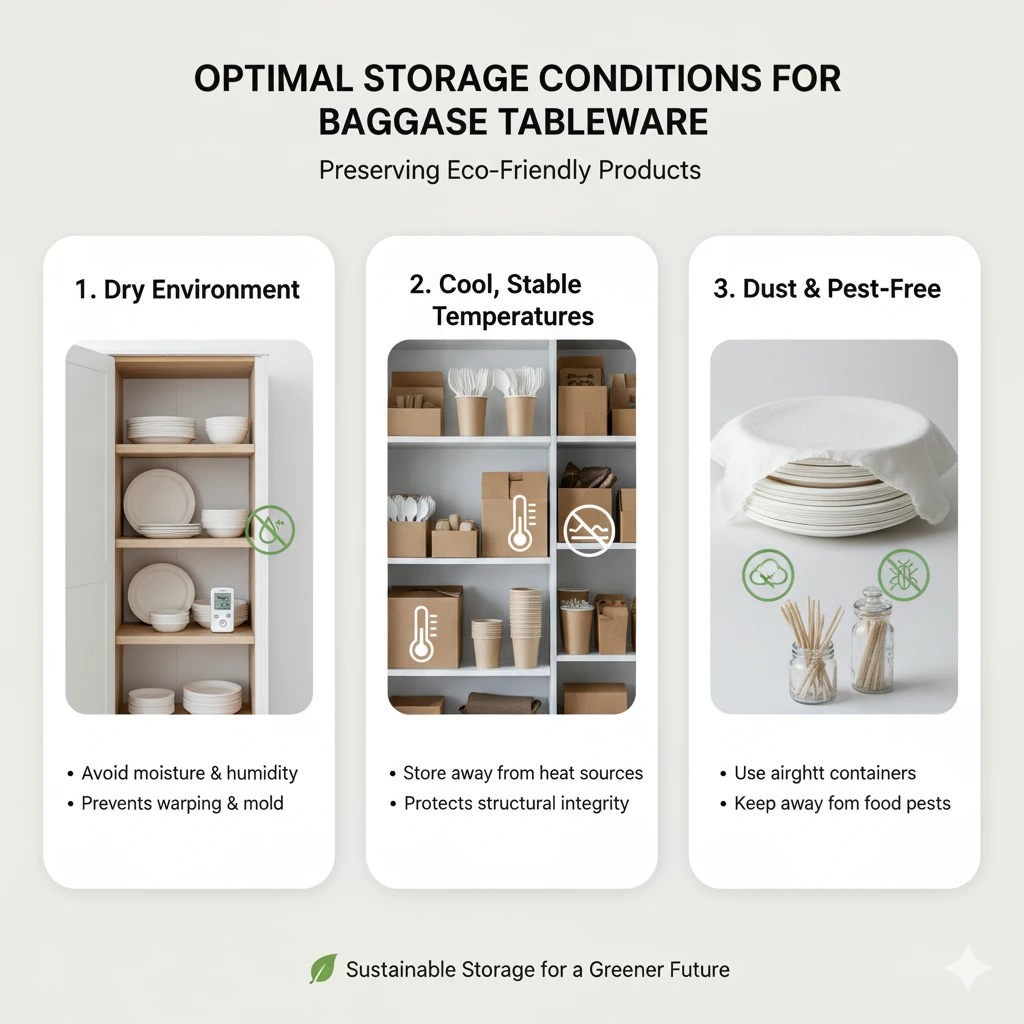
Storing your bagasse tableware like bagasse plate, bagasse bow, bagasse cup correctly is key to keeping it in good shape. Think of it like storing any other natural product; it needs a bit of care to last. The main goal is to keep it dry and away from anything that could make it break down faster than it should.
How to Store Bagasse Tableware Without Damage
1. Keep dry
2. Avoid direct sunlight
3. Stack carefully
4. Store flat or upright
5. Use original packaging
6. Maintain moderate temperature
7. Separate by type
8. Regularly inspect for damage
Maintaining A Dry Environment
Moisture is the biggest enemy of bagasse. When bagasse absorbs water, it can get soft and lose its structure. Always store your bagasse items in a place that is completely dry. This means no damp basements or near sinks where condensation might build up. Even a little bit of humidity over time can start to affect the material. If you've washed your tableware, make sure it's bone dry before putting it away. A quick wipe-down with a towel should do the trick, but air drying is even better if you have the space.
Ensuring Proper Ventilation
While you want to keep things dry, you also don't want to seal bagasse away in an airtight container. Good airflow is important. It helps prevent any residual moisture from getting trapped and causing problems. Think of it like storing bread; you don't want it to get moldy, so you don't put it in a plastic bag and seal it tight. A shelf in a cupboard or a pantry with decent air circulation is usually perfect. This helps keep the material stable and prevents any musty smells from developing.
Avoiding Moisture Accumulation
This point is really about being proactive. Don't just assume a cupboard is dry enough. Check it periodically, especially if you live in a humid climate. If you notice any condensation or dampness, move your bagasse items to a different spot immediately. It's also a good idea to avoid storing them near windows that might get steamy from rain or near appliances that give off heat and moisture. Keeping them off the floor can also help, as floors can sometimes be cooler and more prone to dampness. Proper storage means your bagasse items will be ready to use whenever you need them, without any surprises.
Protecting Bagasse Tableware From Damage
Sugarcane container is pretty tough, but like anything, it can get damaged if you're not careful. You want to keep it in good shape so it lasts and does its job without falling apart. Let's talk about how to avoid common issues.
Preventing Cracking During Handling
Even though bagasse is strong, it's not indestructible. The biggest culprit for damage during handling is usually dropping it or putting too much pressure on it. Think about it if you stack too many bagasse disposable plates without support, or if someone bumps the stack, they can crack. It's also important to handle them gently when you're serving food. Don't just shove a fork into the side of a bowl, for instance. A little care goes a long way.
• Always handle with care, especially around the edges.
• Avoid dropping or stacking too many pieces without proper support.
• When serving, use utensils gently and avoid poking or scraping the surface aggressively.
Avoiding Deformation From Heat
Bagasse can handle hot foods, which is one of its best features. However, there's a limit. If you expose it to extreme heat for too long, like putting it in a conventional oven or leaving it under a heat lamp for an extended period, it can start to warp or even melt. Microwaves are generally fine, but even then, avoid super-long heating times. It's best to stick to the recommended guidelines for reheating.
• Don't put bagasse in a conventional oven.
• Limit microwave heating times to avoid warping.
• Keep away from direct, prolonged heat sources like heat lamps.
Shielding From Excessive Oil
While bagasse has some resistance to liquids and oils, prolonged contact with very oily foods can eventually affect its integrity. The oil can soak into the material over time, potentially making it a bit softer or causing it to lose some of its stiffness. If you're serving something really greasy, it's a good idea to serve it promptly and not let it sit in the bagasse container for hours on end. This helps maintain the tableware's structure and prevents any unwanted absorption.
Best Practices For Storing Bagasse Tableware
Storing your bagasse tableware correctly is key to keeping it in good shape. It's not complicated, but a few simple steps make a big difference. Think of it like storing any other good dishware, but with a little extra attention to moisture and pressure.
Cleaning and Drying Thoroughly
Before you put away any bagasse tableware, like sugarcane disposable plates or bowls, make sure they're clean and completely dry. Even a little bit of leftover food or moisture can cause problems down the line, like mold or weakening the material. Wash them with warm water and a mild soap, just like you would regular dishes. Then, the really important part: dry them thoroughly. You can air dry them, but it's better to give them a quick wipe down with a clean towel to get all the nooks and crannies. This step is super important for preventing any issues with your bagasse food containers or sugarcane containers.
Stacking with Care
When you stack your bagasse tableware, whether it's sugarcane bagasse bowls, bagasse food trays, or even bagasse cups, do it gently. These items are pretty sturdy, but stacking them too high or too tightly can lead to cracking or deformation, especially if they're not perfectly dry. Try to stack similar items together. For instance, stack plates with plates and bowls with bowls. If you have a mix, put the heavier items on the bottom. Avoid placing anything heavy on top of the bagasse packaging. A good rule of thumb is to keep stacks manageable, so they don't put too much pressure on the pieces at the bottom.
Storing in a Stable Location
Find a stable spot for your stored bagasse tableware. This means a place that isn't prone to big temperature swings or high humidity. A dry cupboard or pantry shelf is usually ideal. You want to avoid areas where moisture can easily get in, like near a sink or a steamy dishwasher. Also, keep them away from direct sunlight, as prolonged exposure can sometimes affect the material over time. Keeping your sugarcane tableware in a consistent environment helps maintain its integrity and prevents unexpected damage.
Understanding Bagasse Tableware Durability
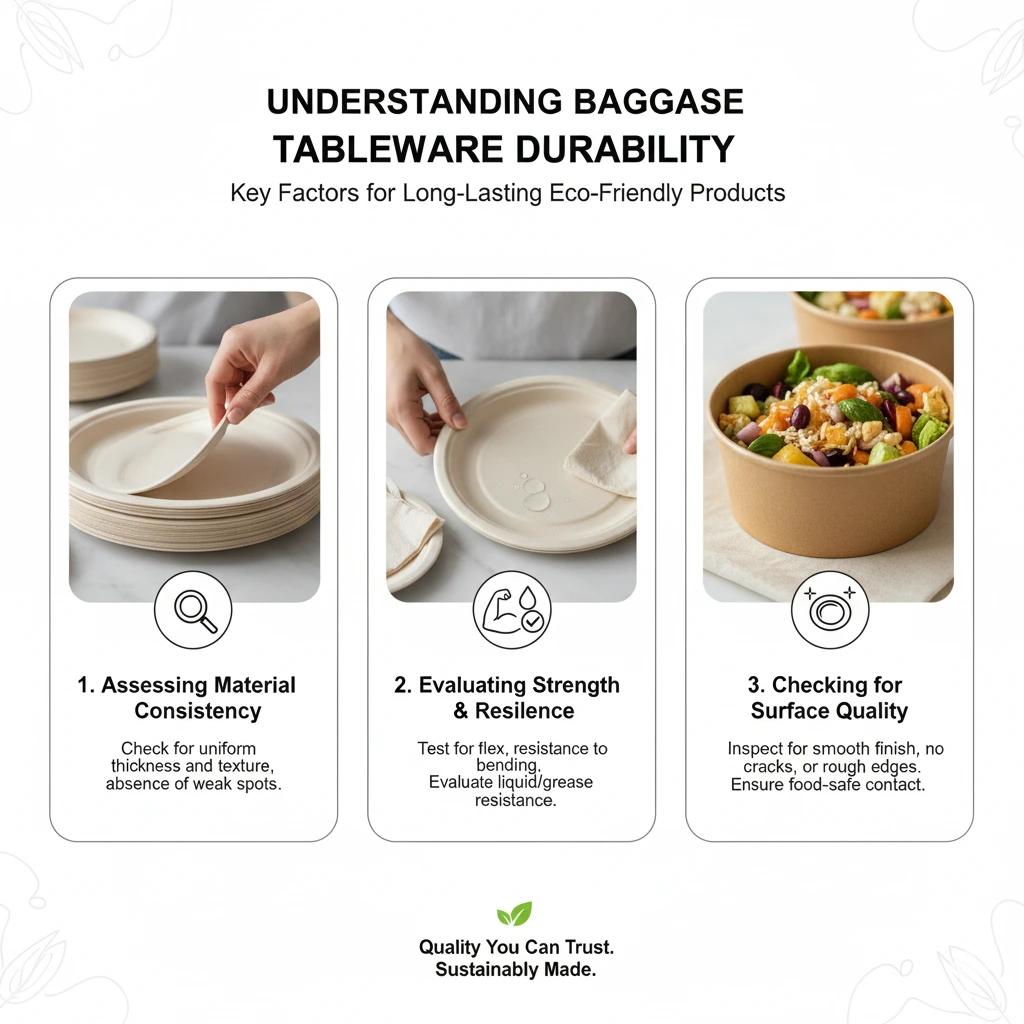
When you're picking out bagasse tableware, it's good to know what makes it strong and reliable. It's not just about being eco-friendly; it's also about whether it can actually do the job without falling apart. Think of it like choosing a sturdy tool you want something that won't let you down when you need it most.
Assessing Material Consistency
This is all about how uniform the bagasse material is. If the thickness and texture are all over the place, you might run into problems. Imagine a plate that's thin in one spot and thick in another; that thin spot could easily crack or leak. Good consistency means the whole piece is made with the same care, so it holds up better, whether you're serving a light salad or a hearty stew. It's about making sure the product performs reliably, every single time.
Evaluating Strength and Resilience
Bagasse tableware is made from sugarcane fibers, and how those fibers are processed really affects how strong the final product is. You want plates and bowls that can handle a good amount of food without bending or breaking. Rigorous tests show that quality bagasse can hold up to heavy portions without buckling. This means you don't have to worry about your plate sagging under the weight of your meal. It's about having tableware that's tough enough for everyday use.
Checking for Surface Quality
Take a good look at the surface. Is it smooth and even, or are there rough patches and imperfections? A smooth surface not only looks better but also suggests a more careful manufacturing process. You're looking for a consistent color and texture, free from any obvious flaws like cracks or chips. This attention to detail in the surface quality often points to a more durable and well-made product overall.
Choosing a Trusted Supplier: Goldleaf
When it comes to high-quality bagasse tableware, Goldleaf is a leading manufacturer and supplier. They specialize in eco-friendly, durable products including plates, bowls, and containers suitable for both everyday meals and catering needs. With strict quality control, uniform material consistency, and smooth finishes, Goldleaf ensures that their bagasse tableware is reliable, strong, and visually appealing, making it an excellent choice for both homes and businesses.
Factors Affecting Bagasse Tableware Integrity
Bagasse tableware, while a fantastic eco-friendly choice, isn't indestructible. A few things can really mess with its sturdiness and how long it lasts. Understanding these factors helps you keep your bagasse plates and bowls in good shape, so they don't end up in the trash sooner than they need to.
Impact Of Prolonged Liquid Contact
Leaving liquids in bagasse tableware for too long is a common culprit for weakening it. Think of it like a really absorbent paper plate, but a bit tougher. When bagasse sits in contact with liquids, especially hot ones, for extended periods, the fibers can start to break down. This can lead to the tableware becoming soggy, losing its shape, and even developing leaks. It's not usually an issue for a typical meal, but if you're serving something very soupy or saucy and letting it sit for hours, you might notice a difference in its integrity.
Consequences Of Extreme Temperatures
Bagasse is pretty good with heat, handling most hot foods without a problem. However, extreme temperatures, both hot and cold, can still have an effect. While it won't melt like some plastics, prolonged exposure to very high heat, like in an oven or directly on a stovetop (which you shouldn't do anyway), can cause it to warp or become brittle. On the flip side, while it's generally freezer-safe, extreme cold for very long durations might make it more prone to cracking if dropped or handled roughly. It's best to avoid subjecting it to temperatures far beyond what's typical for serving food.
Risks Of Storing Oily Foods
Oily foods can also pose a challenge for bagasse tableware. While it has some oil resistance, very greasy or oily items, especially when stored for a long time, can start to break down the material. The oils can penetrate the fibers, potentially leading to a greasy feel or even weakening the structure over time. It's not usually a problem for a quick meal, but if you're planning to store leftovers with a lot of oil in bagasse containers for days, you might want to consider transferring them to a different type of container. It's all about managing expectations and understanding the material's limits.
Ensuring Longevity Of Your Bagasse Tableware
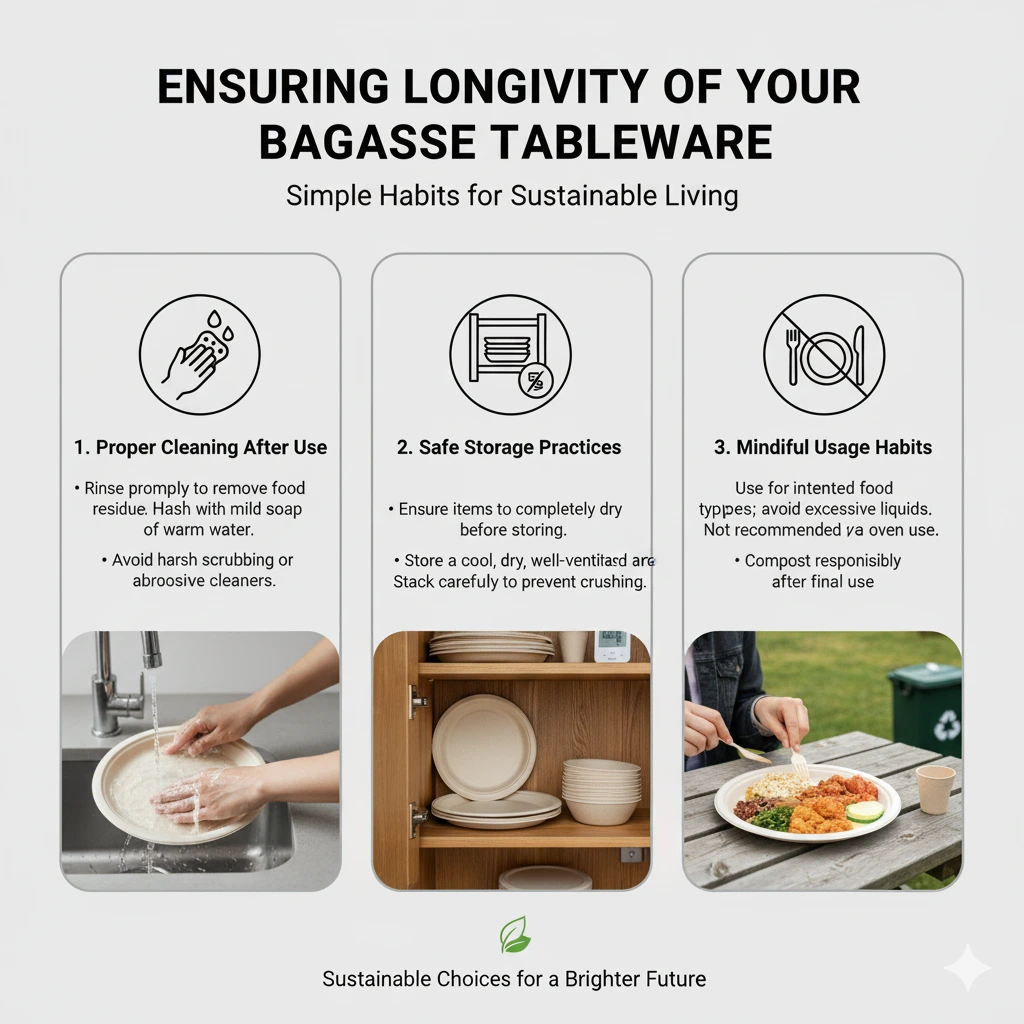
So, you've got this bagasse tableware, right? It's pretty neat stuff, made from sugarcane leftovers, and it's way better for the planet than plastic. But like anything, if you don't treat it right, it won't last as long as it could. Let's talk about how to keep it in good shape.
Proper Cleaning After Use
First things first, don't just shove used bagasse plates into the sink and forget about them. Give them a good wash. Use warm water and a little bit of mild soap. You want to get rid of any food bits or grease.
-
Wash promptly after use to prevent food from drying on.
-
Use a soft sponge or cloth; avoid abrasive scrubbers that could scratch the surface.
-
Rinse thoroughly to remove all soap residue.
Safe Storage Practices
Once they're clean, drying is super important. Moisture is the enemy here. If you stack damp plates, they can get moldy or just generally fall apart faster. Find a spot that's dry and has some air circulation.
Think of it like storing paper you wouldn't leave it in a damp basement, would you? Keep them away from places with a lot of humidity.
Mindful Usage Habits
These plates are tough, but they aren't indestructible. They can handle hot food, sure, and even go in the microwave for a bit (but don't go crazy with the time or heat). What they don't love is sitting around filled with liquids or really oily foods for ages. That can make them get soft. Also, try not to stack them too high or too tightly, especially if they're still a bit warm from food. A little care goes a long way in making them last.
Wrapping It Up: Keeping Your Bagasse Tableware in Great Shape
So, there you have it. Storing your bagasse tableware properly isn't really a big deal, but doing it right means it'll last longer and stay in good condition. Just remember to keep it dry and away from too much moisture or extreme heat, and you'll be good to go. It’s a simple step that helps you get the most out of these eco-friendly dishes. By taking a little care, you're not just saving your tableware, you're also doing a small part for the planet. Pretty neat, right?
Frequently Asked Questions
How do I keep my bagasse plates from cracking?
To stop your bagasse plates from cracking, handle them gently. Avoid bending them too much, especially when they are loaded with food. Storing them flat and not stacking too many pieces on top of each other can also help prevent stress.
Can I put hot food in bagasse bowls?
Yes, bagasse bowls are great for hot food! They can handle warm meals without getting soggy or bending. However, try not to heat them in the microwave for too long, as extreme heat might cause them to change shape a bit.
What's the best way to store leftover bagasse tableware?
The best way to store unused bagasse tableware is in a dry place where air can move around. This helps prevent moisture from causing any issues. Keep them away from direct sunlight or very humid spots.
What happens if bagasse tableware gets wet or oily?
While bagasse is pretty good with liquids and oils, leaving very wet or oily foods in it for a very long time might make the material a bit soft. It's best to use it for meals that aren't extremely greasy or soupy for extended periods.
- منتجات
- Bowl
- Clamshell
- Compartment Plate
- Plate
- Tea Cup
© 2024 , Goldleaf ,
جميع الحقوق محفوظة.
Made & Managed by Lightlink Solutions



